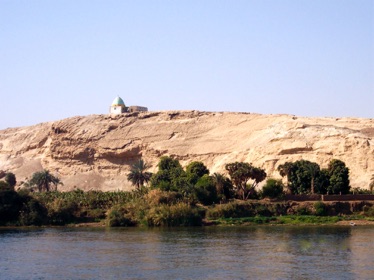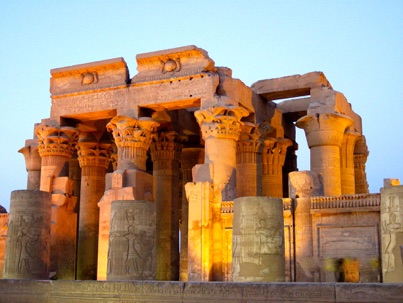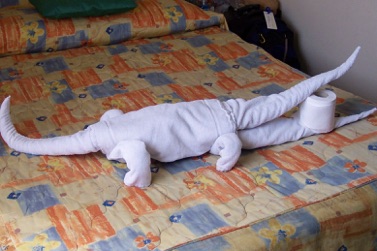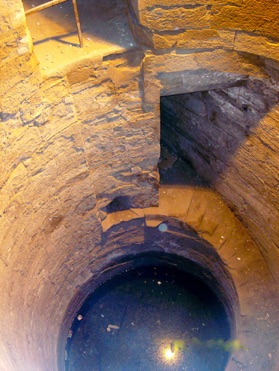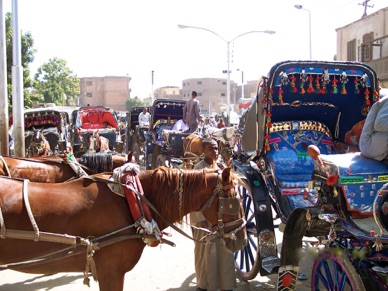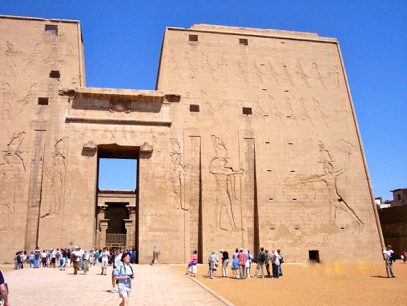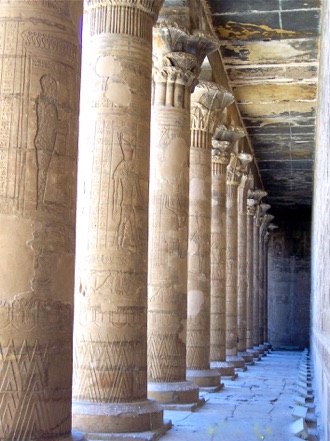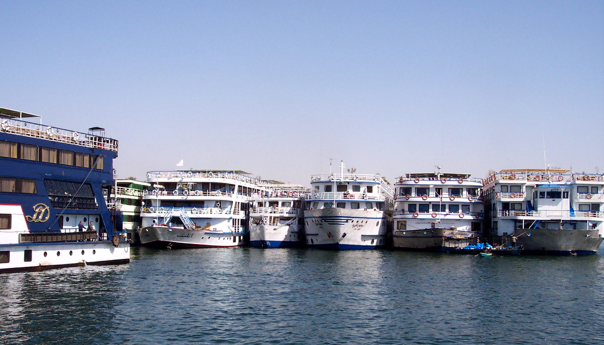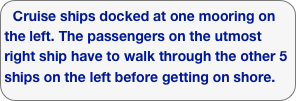a: The Ninfea Due
Sailing down the Nile, or sailing up the Nile, is nowadays usually part of the tour package to Egypt. We were loaded in the Ninfea Due a three-decker, designed for 30-40 passengers only, but with a pretty large crew, since labor was inexpensive. The vessel was 60 meters long, had a beam of 9.8 meters and a fairly shallow draft of only 1.3 meters. The ship was rated a four-star establishment and we were served copious breakfasts and 6-course lunches and dinners daily. Although alcohol is frowned upon for the local Muslim population, foreigners can buy local wines to go with their meals, especially on these luxury ships. The wines are quite good and they cost very little. The Egyptian Government has not learned about the joys yet of taxing alcoholic drinks for more state income.
left: The Ninfea Due
The river is wide but fairly shallow, only 12 to 16 feet in depth. The boats pass each other on the left and on the right, whatever suits their fancy. Because of the large number of boats and the limited moorings at the places of interest, the boats are moored parallel against each other. If you are furthest away, you have to walk through several other boats before getting on shore. I have seen as many as seven boats next to each other on one mooring. You can have your window open when the boat is sailing to enjoy the view. But when you are moored you may soon find a Leviathan moored next to you cutting off any privacy and sunlight to your cabin.
right: Along the banks of the Nile
Along the Nile are many strips of fertile land. Sometimes there are hills parallel to the river. In the area of the Valley of the Kings the hills become mountains. Beyond that is desert, just yellow desert.
From the river you can occasionally see the desert. You can see the mountain ranges where Aida’s father escaped to get to the desert and then go further south. There are also fertile valleys with date trees, sugar cane, corn and other vegetables and mud-colored ruins among the rocks. Brown is the prevalent color.
b: Kom Ombo
left: Kom Ombo lighted up at dusk.
We arrived at the partially reconstructed ruins at Kom Ombo at around 4 p.m. Many farmers who have been displaced by the rising waters because of the Aswan dam have been moved to this area.
But before we reached the temple we had to walk for a few hundred yards past a long row of hawkers and stands selling a huge array of colorful Egyptian garb.
Right: Colorful local garbs for sale at Kom Ombo.
.
The temple is unusual because it is a double temple. It was built during the Ptolemaic dynasty. (118 BC - 286 AD).
To go back a bit into history, Alexander the Great conquered Egypt in 332 BC. After his death in 323 his successors ruled Egypt as the Ptolemaic dynasty, which was the last dynasty of independent Egypt, before it fell to the Romans. The Ptolemies were Greek, but they presented themselves as Egyptians, imitating the traditions of the earlier pharaohs.
After you enter the open court in front of the temple ringed with columns, there are two entrances next to each other in the pylon, the wall separating the court from the next area. You then enter the Hypostyle area. In the opposite wall of the Hypostyle are again two openings next to each other, both leading to the rectangular vestibule area. In the opposite pylon are again
two doors, both leading to the Inner Sanctum area. In the pylon at the opposite end are two chambers next to each other. One is dedicated to the crocodile god Sobek, the god of fertility and cocreator of the world. The altar in the other chamber is dedicated to the falcon-visaged god Horus.
left: A lovely column with colored engravings in Kom Ombo. The two cartouches are of a Ptolemaic pharaoh, but you can see above them the symbols showing “Lord of lower and upper Egypt” and “son of the god Ré”.
Crocodiles are obviously held in high esteem here. Captive crocodiles have been kept on the temple grounds and there were a number of mummified crocodiles on display.
An when we came back to our cabin on the Ninfea Due, our cabin steward had rolled several of the new towels in the shape of a crocodile. Very creative.
right: A crocodile waiting for us on our bed.
Many engravings on the wall show the triumph of the pharaoh over his enemies. There are lions being fed the chopped hands of prisoners. Captured enemies, hands bound, in a row.
On the grounds was also a Nilometer, which was a well with steps around the inside perimeter. The well is connected through an underground channel to the Nile, so the level of the river is the same as in the well. By using markings on the wall, the water levels can be recorded for planning purposes.
Left: Nilometer
In the old days, the level was also used to determine the tax rate of the farmers. How higher the water level, how more water there was. Hence, more crops can be expected and higher taxes were justified.
c: The temple of Horus in Edfu
Some 40 miles north (remember, we are sailing down the Nile river, which means we are going north) we arrived in Edfu, where we were able to view the great temple of Horus, the falcon-headed god, on the west bank of the Nile. From where we landed, colorful caleches took us to the site of the temple.
right: Colorful caleches to get around
Built from blocks of sandstone, the temple is very well preserved. It was built between 237 and 57 BC during the reign of the Ptolemies. There are engravings everywhere, even on the ceilings. Engravings can be made to have the figures stick out. This takes more work and is seen in the more protected areas of the temple. Outside, the engravings are carved in the rock. Many of these engravings were damaged by the Christians, who in their religious fervor were intent on erasing every engraving suggesting bare breasts.
left: The huge entrance pylon to the temple of Horus in Edu.
The main entrance pylon to the temple is more than 100 feet high. In the middle of the picture is Horus, wearing the double crown of Egypt. On the right is the Pharaoh Ptolemeus XII in the process of slaying his enemies. He holds a fighting net in his left hand.
The temple of Horus in Edfu also has many engravings depicting the triumph of Horus over Seth. Going back somewhat, Osiris, the main god, was acclaimed as a wise and noble king. Seth, his brother, was jealous and killed Osiris. He then cut the body in 24 pieces and buried the remains all over the world. That is where Osiris entered the underworld, where he is often depicted as a mummy.
Isis went everywhere and asked everyone and finally managed to assemble the parts together again. Then the god Amun Ré breathed life back into Osiris. Horus was born of Isis and Osiris during this period. When he grew up, he went after Seth and finally killed him in battle. It was the triumph of good over evil.
right: Inside a hallway in the temple of Horus in Edfu. Look how wonderful and graceful the capitals (top of the columns) are.

